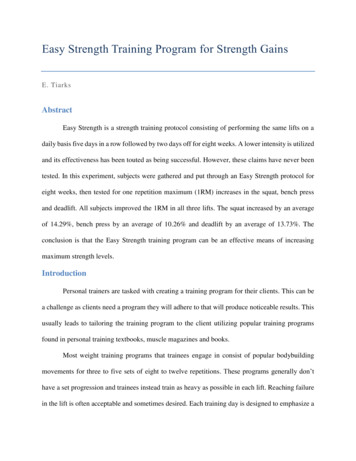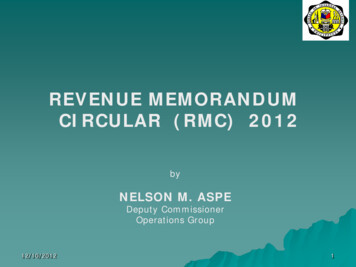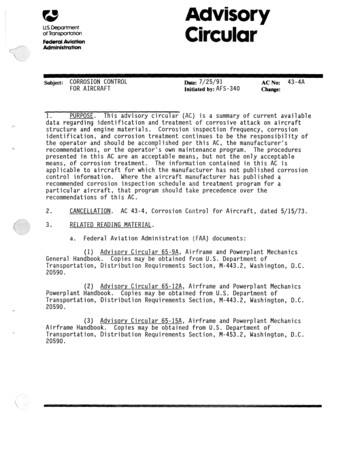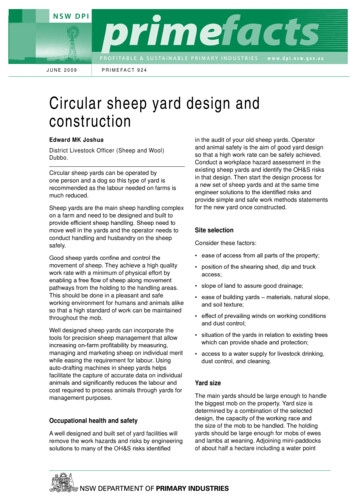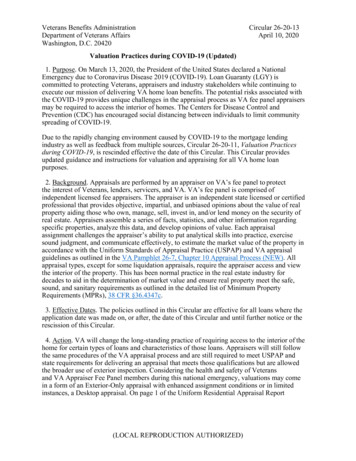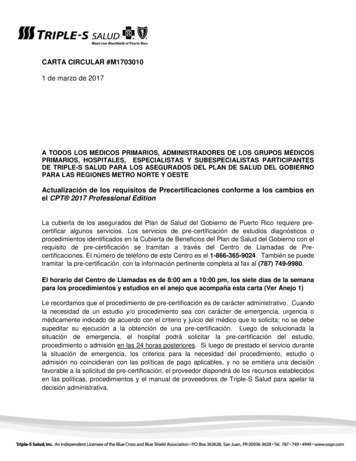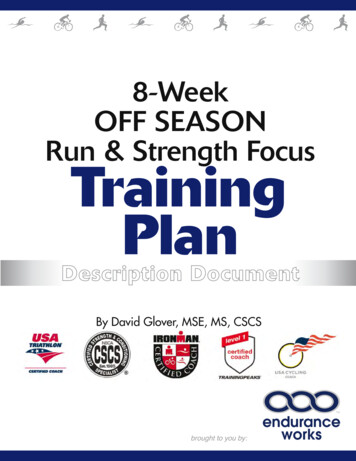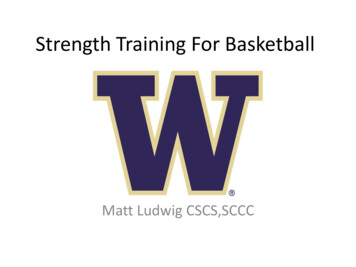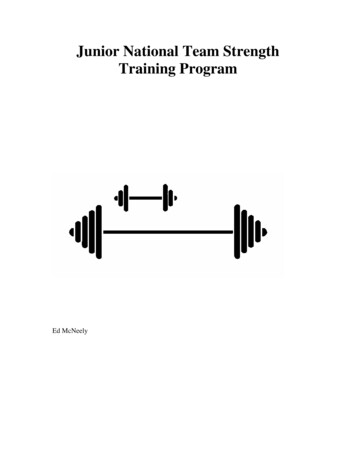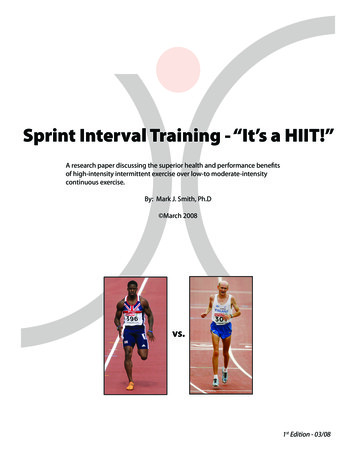
Transcription
International Journal of Multidisciplinary Research and Modern Education (IJMRME)ISSN (Online): 2454 - 6119(www.rdmodernresearch.org) Volume II, Issue I, 2016INFLUENCE OF CIRCULAR STRENGTH TRAININGSYSTEM ON SELECTED PHYSICAL FITNESSCOMPONENTS AND PERFORMANCE VARIABLESAMONG FIELD HOCKEY PLAYERSDr. K. Mohan* & Dr. R. Kalidasan***Assistant Professor, Vinayaka Mission’s College of Physical Education, VinayakaMission’s University, Salem, Tamilnadu** Assistant Professor (SG), Department of Physical Education, BharathidasanUniversity, Tiruchirappalli, TamilnaduAbstract:The purpose of the study was to find out the influence of circular strength trainingon selected physical fitness components and performance namely grip strength, muscularstrength, core strength, muscular flexibility, muscular endurance among male field hockeyplayers. To achieve the purpose of the study thirty male field hockey players have beenrandomly selected from various colleges in the state of Tamil Nadu, India. The age ofsubjects were ranged from 18 to 25 years. The subjects had past experience of at leastthree years in field hockey and only who those represented their respective college teamswere taken as subjects. A series of physical fitness components tests was carried out oneach participant. Grip strength assessed by Grip dynamometer, muscular strength assessedby push ups, core strength assessed by plank test, muscular flexibility assessed by sit andreach, muscular endurance assessed by half squat jump and performance variablesassessed by subjective rating. The subjects were randomly assigned into two groups offifteen each, such as experimental and control groups. The experimental groupparticipated in the circular strength training for 3 days a week, one session per day andfor 12 weeks each session lasted 45 minutes. The control group maintained their dailyroutine activities and no special training was given. The subjects of the two groups weretested on selected variables prior and immediately after the training period. The collecteddata were analyzed statistically through analysis of covariance (ANCOVA) to find out thesignificance difference, if any between the groups. The 0.05 level of confidence was fixed totest the level of significance difference, if any between groups. The results of the studyshowed that there was significant differences exist between circular strength traininggroup and control group. And also circular strength training group showed significantimprovement on grip strength, muscular strength, core strength, muscular flexibility,muscular endurance and performance compared to control group.Key Words: Circular Strength Training, Grip Strength, Core Strength & Biceps CurlIntroduction:Field hockey is a sport with a long history that has undergone quite rapid andradical changes. The advent of the synthetic playing surface has changed the physical,physiological, technical and tactical requirements of the game at all levels, but inparticular at the elite level. Physique and body composition have an important role forplaying field hockey Montgomery, (2006); Quinney et al., (2008) .Tarter et al.,(2009). Infield hockey lots of movements and skills are involved so a high level of physicaldemand is required for match play (Montgomery, 2006; Quinney et al.,(2008) andTarter et al., (2009). Muscle strength one of the dynamic factors of motor performanceand importance lies in that it greatly influential on the speed of motor performance andmotor skill proficiency required and is an important cause of progress performanceMufti (1998). Aweys, (2000) explain that muscle strength is a physical attributes that513
International Journal of Multidisciplinary Research and Modern Education (IJMRME)ISSN (Online): 2454 - 6119(www.rdmodernresearch.org) Volume II, Issue I, 2016contribute to a prominent role in the mastery and development of tactical skill andperformance and have a significant role in highlighting the emergence of some otherphysical attributes. Mohammed (1992) & Abul Ela (1984) indicated that musclestrength is one of the physical attributes important for sports and special games frictionsuch as football and develop longer need to access the individual with a high level andmuscle strength is not only a physical attributes but are the most important physicalattributes upon which to develop other qualities such as speeding, endurance, agilityand flexibility.One of the methods which used to improve the muscular endurance is circularstrength training (CST) which pioneered by Scott Sonnon, and further developed by hiselite Faculty Coaching Staff, CST is the cutting edge of health, fitness and sportsperformance enhancement. It’s unique among fitness systems in offering a complete“health first” approach. Other systems place function (attributes like strength,endurance or speed) first, valuing those things over and often at the expense of health.Circular Strength Training is made up of three “wings” or sub-disciplines. Though theycan and are practiced independently, the three wings of CST integrate seamlessly into astand-alone health and fitness system. Intu-Flow is an incrementally progressive systemof dynamic joint mobility exercises designed to feed and lubricate your joints andconnective tissues and restore all of your joints to their full, healthy range of motion.Beginning CST athletes start with the Intu -Flow, and long term athletes use it to releasestored tension, speed recovery from training, and to maintain the health and longevityof their bodies.Prasara yoga takes the range of motion and coordination that you recovered withthe Intu - Flow to the next level. It transforms physical performance by teaching onehow to re-integrate the breath, movement and structure—the key to accessing flowstate in any activity. Prasara specifically focuses on the releasing of chains of tensionthroughout the body. Tension caused by fear, anxiety, trauma, habit, and even exerciseare pulped and released through the practice of Prasara yoga. Prasara works in theopposite and teaches you to release this habitual tension. Paired with the Intu-Flow,Prasara will give the ability to strut around the stage and contort yourself in a freakishdisplay of athleticism while holding a note and making it look easy.Clubbell Athletics is the third weighted wing of CST. Unlike machines, freeweights, and Kettlebells, the Clubbell was specifically designed to be moved in threedimensions, just as people move in the real world. Clubbell allow one to develop therotary and angular strength of the prime movers (translating directly to athleticperformance in any activity), to develop selective tension (the ability to apply exactlythe right amount of force for the task at hand, rather than the “full on/full off” approachof traditional strength training), and to develop incredible grip strength and stamina.Clubbell Athletics is simply the most sophisticated, fun and creative vehicle for strengthand conditioning ever conceived. (Ryan, 2011). Circular strength training provides atechnique to cover every factor of an individual's remedial, fitness, and sportsperformance. According to the above, and from believe of the researcher that, strongmuscles should carry on strong bone. Hence, the purpose of this study was toinvestigate the effects of influence of circular strength training system on strengthparameters and performance variables among field hockey players.Methodology:To achieve the purpose of the study thirty male field hockey players have beenrandomly selected from various colleges in the state of Tamil Nadu, India. The age ofsubjects were ranged from 18 to 25 years. The subjects had past experience of at least514
International Journal of Multidisciplinary Research and Modern Education (IJMRME)ISSN (Online): 2454 - 6119(www.rdmodernresearch.org) Volume II, Issue I, 2016three years in field hockey and only who those represented their respective collegeteams were taken as subjects. A series of physical fitness components tests was carriedout on each participant. Grip strength assessed by Grip dynamometer, muscularstrength assessed by push ups, core strength assessed by plank test, muscular flexibilityassessed by sit and reach, muscular endurance assessed by half squat jump andperformance variables assessed by subjective rating. The subjects were randomlyassigned into two groups of fifteen each, such as experimental and control groups. Theexperimental group participated in the circular strength training for 3 days a week, onesession per day and for 12 weeks each session lasted 45 minutes. The control groupmaintained their daily routine activities and no special training was given. The subjectsof the two groups were tested on selected variables prior and immediately after thetraining period. The collected data were analyzed statistically through analysis ofcovariance (ANCOVA) to find out the significance difference, if any between the groups.The 0.05 level of confidence was fixed to test the level of significance difference, if anybetween groups.Table 1: Criterion MeasuresTests /ToolsUnit ofS.NoVariablesAdministeredMeasurement1Grip strengthGrip dynamometerIn kg2Muscular StrengthPush upsNumbers3Core strengthPlank testIn seconds (1/100)4Muscular flexibilitySit and ReachCentimeters5Muscular EnduranceHalf Squat JumpNumbers6PerformanceJudges ratingIn PointsTable 2: Descriptive Analysis of Physical Fitness Components and PerformanceVariables among Control and Experimental GroupsPre-TestSDPost –TestSDAdjusteS.NoVariablesGroupMean( )Mean( )d MeanCG57.340.2860.551.0360.581Grip 60.2418.862Muscular .132.58172.153Core 186PerformanceCSTG5.3180.196.390.206.398CG Control GroupCSTG Circular Strength Training GroupThe tables-II the pre, post-test means, standard deviations and adjusted meanson physical fitness components and performance of male field hockey players werenumerical presented. The analysis of covariance on selected variables of control groupand Circular strength training group is presented in table – III515
e strengthMuscularstrengthGrip strengthInternational Journal of Multidisciplinary Research and Modern Education (IJMRME)ISSN (Online): 2454 - 6119(www.rdmodernresearch.org) Volume II, Issue I, 2016Table 3: Computation of Analysis of Covariance on Physical Fitness Componentsand Performance Variables among Male Field Hockey PlayersVariaSum ofMeanS.NoTestSum of VariancedfF ratioblesSquaresSquareBetween groups0.3610.36Pre-test2.17Within groups4.71280.16Between groups6.8216.821Post-test11.91*Within groups16.02280.57Between sets5.5515.55Adjusted9.56*meansWithin sets15.67270.58Between groups0.0610.06Pre-test0.81Within groups2.13280.07Between groups10.79110.792Post-test32.24*Within groups9.37280.33Between sets10.25110.25Adjusted29.69*meansWithin sets9.33270.34Between groups0.0510.05Pre-test0.15Within groups9.33280.33Between groups92.76192.763Post-test26.32*Within groups98.66283.52Between sets89.96189.96Adjusted25.28*meansWithin sets96.08273.55Between groups0.0910.09Pre-test1.30Within groups1.93280.06Between groups3.2213.224Post-test6.04*Within groups14.90280.53Between sets3.2913.29Adjusted5.99*meansWithin sets14.82270.54Between groups0.0510.05Pre-test0.75Within groups2.05280.07Between groups7.6517.655Post-test13.74*Within groups15.60280.55Between sets7.2917.29Adjusted12.65*meansWithin sets15.56270.57Between groups0.1110.11Pre-test3.15Within groups1.01280.03Between groups0.3310.336Post-test6.62*Within groups1.43280.05Between sets0.3110.31Adjusted5.98*meansWithin sets1.42270.05*Significant at 0.05level of confidences(The table values required for significance at 0.05 level of confidence for 1 & 28 and 1 & 27are 4.21 and 4.20 respectively).In the table the results of analysis of covariance on grip strength, muscularstrength, core strength, muscular flexibility muscular endurance and performance. Theobtained ‘F’ ratio of 2.17, 0.81, 0.15, 1.30, 0.75 and 3.15 for Pre-test means was less thanthe table value of 4.21 for df 1 and 28 required for significance at 0.05 level of516
International Journal of Multidisciplinary Research and Modern Education (IJMRME)ISSN (Online): 2454 - 6119(www.rdmodernresearch.org) Volume II, Issue I, 2016confidence on grip strength, muscular strength, core strength, muscular flexibility,muscular endurance and performance. The obtained ‘F’ ratio of 11.91, 32.24, 26.32,6.04, 13.74 and 6.62 for post-test means was greater than the table value of 4.21 for df 1and 28 required for significance at 0.05 level of confidence on grip strength, muscularstrength, core strength, muscular flexibility muscular endurance and performance. Theobtained ‘F’ ratio of 9.56, 29.69, 25.28, 5.99, 12.65 and 5.98 for adjusted post-test meanswas greater than the table value of 4.20 for df 1 and 27 required for significance at 0.05level of confidence on grip strength, muscular strength, core strength, muscularflexibility muscular endurance and performance. The result of the study indicated thatthere was a significant difference among the adjusted post test means of Circularstrength training group and control group on grip strength, muscular strength, corestrength, muscular flexibility, muscular endurance and performance. And also Circularstrength training group showed significant improvement on grip strength, muscularstrength, core strength, muscular flexibility, muscular endurance and performancecompared to control group.Figure 1: The pre, post and adjusted mean values of grip strength, muscular strength,core strength, muscular flexibility, muscular endurance and performance index of bothcontrol and experimental groups are graphically represented in the fig
Clubbell Athletics is simply the most sophisticated, fun and creative vehicle for strength and conditioning ever conceived. (Ryan, 2011). Circular strength training provides a technique to cover every factor of an individual's remedial, fitness, and sports performance. According to the above, and from believe of the researcher that, strong
